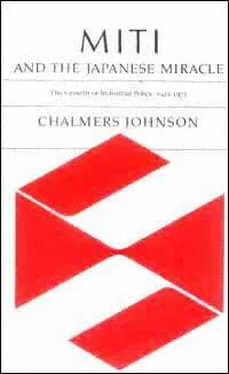Chalmers Johnson - MITI and the Japanese miracle
Здесь есть возможность читать онлайн «Chalmers Johnson - MITI and the Japanese miracle» весь текст электронной книги совершенно бесплатно (целиком полную версию без сокращений). В некоторых случаях можно слушать аудио, скачать через торрент в формате fb2 и присутствует краткое содержание. Год выпуска: 2007, Издательство: Stanford University Press, Жанр: Старинная литература, на английском языке. Описание произведения, (предисловие) а так же отзывы посетителей доступны на портале библиотеки ЛибКат.
- Название:MITI and the Japanese miracle
- Автор:
- Издательство:Stanford University Press
- Жанр:
- Год:2007
- ISBN:нет данных
- Рейтинг книги:3 / 5. Голосов: 1
-
Избранное:Добавить в избранное
- Отзывы:
-
Ваша оценка:
- 60
- 1
- 2
- 3
- 4
- 5
MITI and the Japanese miracle: краткое содержание, описание и аннотация
Предлагаем к чтению аннотацию, описание, краткое содержание или предисловие (зависит от того, что написал сам автор книги «MITI and the Japanese miracle»). Если вы не нашли необходимую информацию о книге — напишите в комментариях, мы постараемся отыскать её.
MITI and the Japanese miracle — читать онлайн бесплатно полную книгу (весь текст) целиком
Ниже представлен текст книги, разбитый по страницам. Система сохранения места последней прочитанной страницы, позволяет с удобством читать онлайн бесплатно книгу «MITI and the Japanese miracle», без необходимости каждый раз заново искать на чём Вы остановились. Поставьте закладку, и сможете в любой момент перейти на страницу, на которой закончили чтение.
Интервал:
Закладка:
67
One of the more innovative aspects of the early JETRO was its funding. During the 1954 recession MITI raised the money for it from the import of bananas. Under the system of foreign exchange quotas, licenses to import bananas and sugar had become the most valuable in the country; supplies of both commodities were in such short supply that any amounts that could be brought to market commanded exorbitant prices. In the case of bananas, the government charged importers a tax on their profits and turned the proceeds over to JETRO. The organization's funds grew from slightly under ¥3 million in 1954 to over ¥100 million in 1955, all because of bananas. This scheme was similar to the sugar-link system for subsidizing ship exports. Between 1953 and 1955 MITI would issue import licenses for sugar to trading companieswhich were then selling Cuban sugar in Japan at from two to ten times the import priceonly if they had allied themselves with a shipbuilder and could submit an export certificate showing that they had used 5 percent of their profits to subsidize ship exports. For the two years it was in effect, the sugar-link system supplied some ¥10 billion to the shipbuilding industry. It ultimately had to be stopped because too many other industries wanted subsidies from the sugar and banana fees and because the IMF frowned on the practice.
68
The sugar and banana links were only two of the more spectacular tax breaks that Ministry of Finance and Enterprises Bureau officials invented in this era to aid industries and to help commercialize particular products. Nakamura Takafusa argues that tax exemptions replaced direct subsidies as early as 1951 as the main means by which the government pursued its industrial policy.
69
And it is certainly true that after Dodge cut off subsidies created through price differentials and RFB loans, MITI's Enterprises Bureau moved decisively into the tax field in search of alternatives.
The main obstacle to its work was the lingering influence of SCAP's special tax mission, which Prof. Carl S. Shoup of Columbia University had headed, and which included such experts as Jerome B. Cohen of the City College of New York. In the spring of 1949 the Shoup mission accompanied Dodge to Japan, and it delivered its report in September. The Ministry of Finance held the mission in high regard, and its
Page 233
advice on the proper system of national and local taxes in Japan still carried great weight during the period 1950 to 1955. In essence, Shoup had called for a simplification of the tax system that would aggregate all types of income of a taxpayer (whether an individual or a "juridical person") and eliminate to the greatest degree possible the special tax benefits that were contained in the Taxation Special Measures Law (Sozei Tokubetsu Sochi Ho *, number 15 of 1946) and its numerous amendments.
Some of Shoup's proposals, such as a locally controlled value-added tax, were simply too advanced for the time; businessmen were outraged at the thought that they might have to pay a tax even when operating at a deficit, and it was quietly abandoned. But Shoup's ideas were not necessarily hostile to the use of the tax system to stimulate the economy. For example, his advocacy of a revaluation of assets in the light of Japan's inflation as a way to enhance the capitalization of enterprises met with a very favorable response and resulted in the passage of the Capital Assets Revaluation Law (Shisan Saihyoka* Ho, number 110 of April 1950). This statute literally created capital where none had existed before by a (downward) reassessment of industrial assets for tax purposes, a process that was conducted some three different times between 1950 and 1955.
But the main problem with the Shoup system was its hostility to the preferential treatment of strategic industries. Ikeda felt that Japan had to go in this directionalthough of course it meant an increasingly inequitable distribution of tax burdens throughout the societyand many of his Finance Ministry colleagues followed his lead because they preferred tax exemptions to subsidies on practical grounds. As Yoshikuni Jiro* (former director of the National Tax Agency and vice-minister of finance) has put it, taxes are better than subsidies, even though they are the same thing in theory, because a tax advantage is valuable only after an enterprise has done what the government wants it to do, whereas a subsidy is paid prior to performance and sometimes does not produce any improvement in performance.
70
Another reason to prefer tax breaks to subsidies is their lower political saliencea feature of some value to Japanese bureaucrats during the 1950's in light of the Showa* Denko* and other scandals associated with the early occupation era.
*


*
Randall Bartlett's comments are apropos: "Specific tax breaks offered to particular farms and industries act, in effect, like governmental subsidies to these agents. Rather than directly taking money from other segments of society and redistributing it to these firms through the budget process, these tax concessions merely leave them with greater financial resources (and lower costs). The resources which finance this subsidy are essentially the higher taxes paid by other agents. Because the use of taxes elimi-
(footnote continued on next page)
Page 234
Beginning in 1951 the Ministry of Finance, in consultation with the Enterprises Bureau of MITI and the Industrial Rationalization Council, proceeded very slowly with annual revisions of the old Taxation Special Measures Law, which resulted by the end of the decade in the complete dismantling of the Shoup system. Among the ministry's actions were the exclusion of up to 50 percent of a firm's income earned from exports (this was raised to 80 percent by the tax revision of 1955), rapid depreciation of designated investments for industrial rationalization, exclusion of strategic machinery from import duties, deductions for royalties paid for foreign technology, and many others. A "deliberation council" controlled by the Ministry of Finance supervised and approved these annual revisions. In 1959 this council, renamed the Tax System Deliberation Council (Zeisei Chosa * Kai), became a permanent organ of the prime minister's office. It, and not the cabinet or the Diet (which normally only rubber-stamps its recommendations), makes annual revisions in the tax system in the light of changing needs and economic conditions. The minister of finance chooses the council's members, and its proceedings are not open to the public. After the creation of the LDP the council became the Finance Ministry's main tool for attempting to prevent the party from politicizing the tax system.
71
Among the more creative of the special tax measures invented during the 1950's were the "reserve funds" set up to assist developing industries. These came in two types,
hikiatekin
, which are normal, accepted reserves of the sort found in most nations' corporation tax laws, and
jumbikin
, which the Ministry of Finance describes candidly as "those reserves which may not be duly justified by generally accepted accounting principles."
72
Both types of reserves can be excluded from taxable profits. The best-known of the hikiatekin is that used for lump-sum payments to employees when they retire. This reserve fund was authorized in 1952 following an incident in which an automobile repair facility run by the U.S. military at the Yokosuka naval base was closed down and all the employees fired without receiving any retirement allowance. In order to prevent a recurrence of the turmoil that surrounded the case, the government authorized re-
Читать дальшеИнтервал:
Закладка:
Похожие книги на «MITI and the Japanese miracle»
Представляем Вашему вниманию похожие книги на «MITI and the Japanese miracle» списком для выбора. Мы отобрали схожую по названию и смыслу литературу в надежде предоставить читателям больше вариантов отыскать новые, интересные, ещё непрочитанные произведения.
Обсуждение, отзывы о книге «MITI and the Japanese miracle» и просто собственные мнения читателей. Оставьте ваши комментарии, напишите, что Вы думаете о произведении, его смысле или главных героях. Укажите что конкретно понравилось, а что нет, и почему Вы так считаете.












